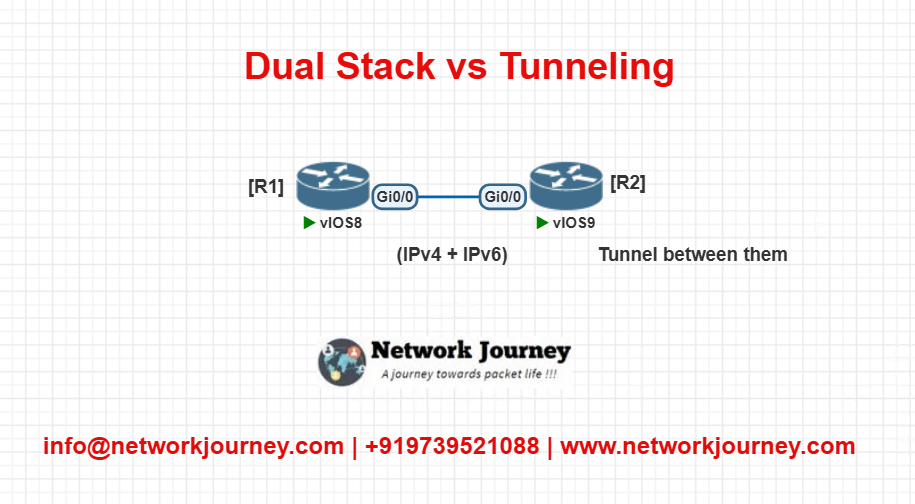Dual Stack vs Tunneling: Which IPv6 Transition Strategy is Right for You? [CCNP ENTERPRISE]
If you’re reading this, you’re probably at that point in your IPv6 learning journey where the real challenge isn’t IPv6 itself—it’s the transition from IPv4. The world isn’t flipping a switch overnight. Most networks still run IPv4, and we need mechanisms to make IPv6 work alongside or over IPv4 until full migration happens.
That’s where Dual Stack and Tunneling come in. In this blog, I’ll walk you through both techniques with real-world scenarios, EVE-NG labs, CLI examples, and FAQs. We’ll keep it simple, practical, and certification + job-focused.
Let’s decode these transition technologies.
Table of Contents
Theory in Brief
IPv6 and IPv4 are not compatible protocols. This means an IPv6-only device cannot directly talk to an IPv4-only device. To ensure a smooth transition, we use transition mechanisms—tools and techniques that let IPv6 and IPv4 coexist or communicate.
1. Dual Stack
This is the most recommended method. A device or network runs both IPv4 and IPv6 stacks simultaneously. It can communicate with either IPv4 or IPv6 devices as needed. Think of it as speaking two languages natively.
2. Tunneling
Tunneling is like putting IPv6 packets inside IPv4 packets. This lets IPv6 traffic move across IPv4-only networks. There are many types of tunnels:
- Manual Tunnels
- 6to4 Tunnels
- ISATAP
- GRE over IPv4
Each has its pros and cons based on security, ease of deployment, and address requirements.
3. NAT64 / DNS64 (Mention Only Briefly)
While not covered in this blog (saved for another post), NAT64 and DNS64 allow IPv6-only hosts to reach IPv4 servers. This is translation, not tunneling.
The choice between Dual Stack and Tunneling depends on infrastructure, security policies, and migration plans.
Summary – Dual Stack vs Tunneling
| Feature | Dual Stack | Tunneling |
|---|---|---|
| Deployment Complexity | Moderate (Requires config) | High (Encapsulation overhead) |
| IPv4 & IPv6 Support | Both natively supported | IPv6 over IPv4 infrastructure |
| Address Requirement | Requires both IPv4 and IPv6 | Requires only IPv6 on edge nodes |
| Performance | Native (Fastest) | Slightly slower (due to overhead) |
| Compatibility | Full with both protocols | Only with tunnel-aware devices |
| Use Case | Enterprises, Datacenters | Across IPv4-only ISPs or legacy |
Essential CLI Commands
| Purpose | Command | Description |
|---|---|---|
| Enable IPv6 Routing | ipv6 unicast-routing | Global mode to allow IPv6 processing |
| Assign IPv6 Address (Dual Stack) | ipv6 address 2001:db8::1/64 | On interface with IPv4 already configured |
| Manual Tunnel Creation | interface Tunnel0tunnel mode ipv6iptunnel source Xtunnel destination Y | IPv6 over IPv4 tunnel |
| Show IPv6 Interface | show ipv6 interface brief | Verify IPv6 address and status |
| Verify Tunnel Interface | show interface tunnel0 | Check tunnel status |
| Show IPv6 Route | show ipv6 route | Displays learned and static routes |
| Ping IPv6 Over Tunnel | ping ipv6 <remote-ipv6> | Checks end-to-end IPv6 reachability |
| Debug Tunnel | debug tunnel | Monitor tunnel events |
Real-World Use Cases
| Scenario | Mechanism Used | Why it’s Preferred |
|---|---|---|
| Datacenter running both protocols | Dual Stack | Supports legacy and modern clients |
| ISP IPv4 core with IPv6 edge | Manual/GRE Tunnel | Avoids full infrastructure change |
| Remote IPv6 branch over IPv4 WAN | ISATAP or GRE | Simplifies IPv6 rollout over IPv4 WANs |
| Testing IPv6 without changing infra | 6to4 Tunnel | Quick setup for lab/testing |
EVE-NG LAB – Dual Stack & Tunnel
LAB TOPOLOGY

- R1 and R2 have Dual Stack on interfaces
- An IPv6-over-IPv4 tunnel connects them
Configuration: Router R1
ipv6 unicast-routing
interface g0/0
ip address 192.168.1.1 255.255.255.0
ipv6 address 2001:db8:1::1/64
interface Tunnel0
ipv6 address 2001:db8:100::1/64
tunnel source 192.168.1.1
tunnel destination 192.168.1.2
tunnel mode ipv6ip
Configuration: Router R2
ipv6 unicast-routing
interface g0/0
ip address 192.168.1.2 255.255.255.0
ipv6 address 2001:db8:1::2/64
interface Tunnel0
ipv6 address 2001:db8:100::2/64
tunnel source 192.168.1.2
tunnel destination 192.168.1.1
tunnel mode ipv6ip
Verification Commands
show ipv6 interface brief
show interface tunnel0
ping ipv6 2001:db8:100::2
If the ping works, your tunnel is successfully passing IPv6 over IPv4!
Troubleshooting Tips
| Symptom | Cause | Solution |
|---|---|---|
| Tunnel interface down | Missing source/dest IP | Check tunnel config |
| No IPv6 connectivity | IPv6 not enabled | Run ipv6 unicast-routing |
| Can’t ping over tunnel | ACLs blocking GRE | Check firewall/ACL for tunnel protocols |
| Routes not appearing | No routing protocol or static | Configure OSPFv3/EIGRPv6 or static route |
| No dual stack traffic | Missing IPv6 on interface | Verify IPv6 address + neighbor status |
FAQs on IPv6 Transition Mechanisms
1. What is the main purpose of IPv6 transition mechanisms?
Answer:
The main purpose is to enable communication between IPv4 and IPv6 networks during the migration phase. Since IPv4 and IPv6 are not natively compatible, these mechanisms ensure that networks can interoperate while the world gradually shifts to IPv6.
2. How does Dual Stack work?
Answer:
Dual Stack allows devices to run both IPv4 and IPv6 protocols simultaneously. Interfaces are configured with both IPv4 and IPv6 addresses, and the device decides which protocol to use based on destination IP.
Key features:
- Both stacks are active at the same time
- Routing tables and DNS resolve for both IP versions
- Native communication—no encapsulation needed
3. What are the advantages of using Dual Stack?
Answer:
Advantages of Dual Stack:
- Native communication – no tunneling or encapsulation required
- Better performance – IPv6 runs directly without additional headers
- Application compatibility – Supports apps working on either IP version
- Gradual migration – Network admins can migrate one service at a time
4. What is IPv6 Tunneling and when is it used?
Answer:
IPv6 Tunneling is the process of encapsulating IPv6 packets inside IPv4 packets to allow them to travel across IPv4 infrastructure.
It is used when:
- You want to connect two IPv6-enabled sites over an IPv4-only WAN
- You don’t want to upgrade the core network immediately
- You want to test IPv6 connectivity without changing existing setup
5. What are the types of IPv6 Tunnels?
Answer:
The main types of IPv6 tunnels include:
- Manual IPv6 over IPv4 Tunnel – statically defined source/destination
- GRE Tunnel – Generic Routing Encapsulation for multiprotocol
- 6to4 Tunnel – Automatically creates tunnel using IPv4-mapped IPv6
- ISATAP – For intra-site IPv6 over IPv4 with automatic address generation
Each has different use cases and configuration complexities.
6. How do I choose between Dual Stack and Tunneling?
Answer:
Your choice depends on network goals, infrastructure, and long-term plans:
| Criteria | Preferred Mechanism |
|---|---|
| Long-term production | Dual Stack |
| Temporary IPv6 support | Tunneling |
| Testing & labs | Tunneling (Manual/6to4) |
| Full protocol support | Dual Stack |
Dual Stack is ideal when IPv6 and IPv4 coexist fully. Tunnels are good for bridging IPv6 gaps across IPv4 networks.
7. Do I need IPv4 addresses to use IPv6 tunnels?
Answer:
Yes. Even though the payload is IPv6, the tunnel endpoints (source and destination) rely on IPv4 addresses to establish the tunnel.
Tunnel interfaces typically require:
- IPv6 address (for encapsulated traffic)
- IPv4 reachability (for tunnel transport)
So you must configure both IPv4 and IPv6 correctly.
8. Is Dual Stack more secure than Tunneling?
Answer:
Answer:
By default, neither is inherently more secure. However:
- Dual Stack introduces a larger attack surface (both protocols must be secured)
- Tunnels may bypass security devices or firewalls if not properly filtered
Security Tips:
- Apply firewall rules for both IPv4 and IPv6
- Use IPsec if confidentiality or integrity is needed over tunnels
- Monitor traffic on both protocol stacks
9. What are common troubleshooting issues in IPv6 tunneling?
Answer:
Common problems and their likely causes:
| Problem | Likely Cause |
|---|---|
| Tunnel down | Incorrect source/destination IP |
| Can’t ping over tunnel | ACL/firewall blocking GRE/IPv6 |
| No IPv6 route over tunnel | Missing static or dynamic route |
| Tunnel interface shows “up/down” | Destination unreachable via IPv4 |
Fixes:
- Ensure both ends can reach each other via IPv4
- Use
show interface tunnelanddebug tunnelfor diagnostics - Check for ACLs or NAT issues blocking tunnel ports
10. Will IPv6 transition mechanisms still be needed in 10 years?
Answer:
Answer:
Most likely, yes—at least in part. While adoption is growing, many enterprises and ISPs still heavily rely on IPv4. Dual Stack and tunneling will continue to play a role until:
- IPv6 becomes the default protocol
- IPv4 is completely deprecated (unlikely in the near future)
- Applications and networks move entirely to IPv6-native designs
So, learning transition mechanisms remains a future-proof investment for engineers.s.
YouTube Link
Class 1 CCNP Enterprise Course and Lab Introduction | FULL COURSE 120+ HRS | Trained by Sagar Dhawan
Final Note
Understanding how to differentiate and implement Dual Stack vs Tunneling: Which IPv6 Transition Strategy is Right for You? is critical for anyone pursuing CCNP Enterprise (ENCOR) certification or working in enterprise network roles. Use this guide in your practice labs, real-world projects, and interviews to show a solid grasp of architectural planning and CLI-level configuration skills.
If you found this article helpful and want to take your skills to the next level, I invite you to join my Instructor-Led Weekend Batch for:
CCNP Enterprise to CCIE Enterprise – Covering ENCOR, ENARSI, SD-WAN, and more!
Get hands-on labs, real-world projects, and industry-grade training that strengthens your Routing & Switching foundations while preparing you for advanced certifications and job roles.
Email: info@networkjourney.com
WhatsApp / Call: +91 97395 21088
Upskill now and future-proof your networking career!
![Dual Stack vs Tunneling: Which IPv6 Transition Strategy is Right for You? [CCNP ENTERPRISE]](https://networkjourney.com/wp-content/uploads/2025/07/nj-blog-post-Dualstack.jpg)
![[Day 70] Cisco ISE Mastery Training: Wireless NAC End-to-End Lab Validation](https://networkjourney.com/wp-content/uploads/2025/08/Day-70-Cisco-ISE-Mastery-Training-Wireless-NAC-End-to-End-Lab-Validation.png)
![Security Zones Explained: From Flat Networks to Fortresses [CCNP ENTERPRISE]](https://networkjourney.com/wp-content/uploads/2025/07/nj-blog-post-security-zone.jpg)
